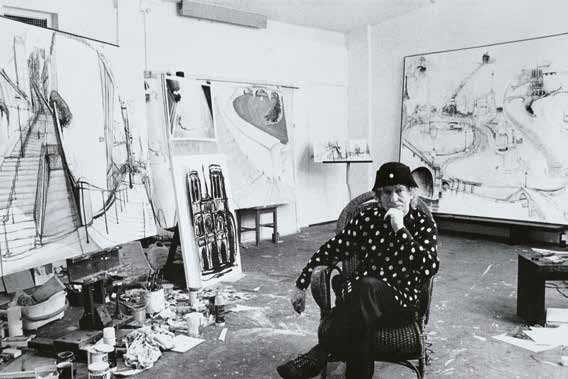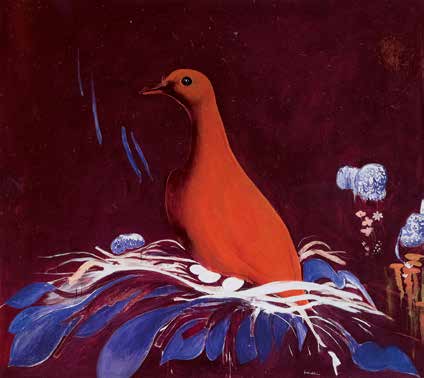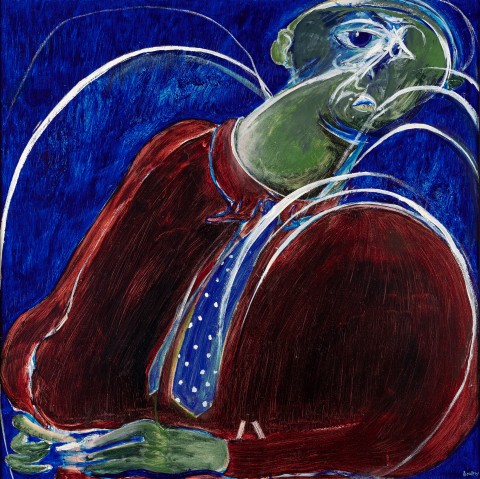THE FRENCHMAN, 1987
BRETT WHITELEY
oil in canvas
83.0 x 83.0 cm
signed lower right: brett W
signed, dated and inscribed with title verso: THE FRENCHMAN / brett whiteley 1987
Robin Gibson Gallery, Sydney
Private collection, Sydney, acquired from the above in 1987
Sutherland, K., Brett Whiteley: Catalogue Raisonné, Schwartz Publishing, Melbourne, 2020, cat. 50.87 (addendum)
1 whit.jpg

By the time Brett Whiteley painted The Frenchman, 1987, he was undoubtedly Australia’s most well-known contemporary artist, recognised and celebrated for his artistic achievements as much as for his embodiment of the persona of the artist-genius – freewheeling, unpredictable, eccentric, and brilliant. While it was a role that Whiteley played well, he had also been struggling for over a decade with heroin addiction, a battle that he openly discussed in interviews and occasionally explored in his work, including in his Archibald Prize-winning painting Art, Life and the Other Thing of 1978. Sadly, Whiteley also fulfilled the artist cliché of dying young – of an overdose, in 1992. He was 53 years old.
Despite having attended John Santry’s sketch club in Northwood, Sydney and life-drawing classes at the Julian Ashton Art School, Whiteley was largely self-taught. He learnt much from studying the work of other artists, and across the early years of his career it is possible to discern the influence of many – from fellow Australians William Dobell, Russell Drysdale, Sali Herman and Lloyd Rees (who Whiteley referred to as one of his ‘little gods’1) to Amedeo Modigliani, Giorgio Morandi, William Scott, and Vincent van Gogh. As Australian critic Robert Hughes wrote of the artist in the mid-1960s as Whiteley was taking London by storm:
‘Every painting of Whiteley’s is a roll in the hay with the muse of art history: as soon as an issue about the nature of art or perception was raised by another painter – Gorky, de Kooning, Bacon, Giacometti, Rauschenberg, Johns, Warhol, Piero della Francesca, Uccello, Masaccio – Whiteley was into it, either painting his way through it or arguing it out. His intellectual appetite is matched by no other Australian painter I’ve met. Like Ashile Gorky, with whose early years Whiteley’s have much in common, his outstanding act as a painter is the decision not to be original – not to narrow his style into the crippling uniqueness of a trademark, but to keep it open, and to preserve the flow of ideas between his art environment and his own experience.’2
1 white.jpg

Yet despite his debt to art history, Whiteley’s work was undeniably his own – characterised by his extraordinary draughtsmanship, his facility of line, and for his capacity to create a sensory overload through an accumulation of forms, movement, rapid brushwork, and the combination of different materials (from product packaging and tree branches to the artist’s own hair). Figures push against the edges of the canvas, their forms stretched and distorted; perspectives tilt, and even the works’ empty spaces – with their vast swathes of yellow, blue, and orange, are ‘electrified.’3 Portraiture was a constant of Whiteley’s career and his numerous paintings and drawings of Wendy Whiteley – the artists’ wife and muse for over three decades, are rightly prized for the way in which their curvilinear lines capture her voluptuous form; for their relaxed intimacy, and for their celebration of sensuality and sexual pleasure.
Whiteley began making self-portraits just prior to his 1967 arrival in New York with Wendy and their young daughter Arkie after he was awarded a Harkness Fellowship, and his self-portraiture continued into the 1980s. Interested in schizophrenia and madness, the artist’s harrowingly honest likenesses often investigate a sense of psychological turmoil through the extreme distortion and elongation of his face, as well as the inner toll of Whiteley’s constant quest – for the next great work, or for ‘enlightenment’ or peace – we can’t know. As Whiteley said: ‘one gets into the habit of having an invented world – the external world is so repugnant. It’s a natural schizing and I became addicted to the split.’4
The bird was a recurring motif for Whiteley, and birds, eggs and nests occur as subjects, and as real-life collage elements, across the artist’s oeuvre. A favourite animal since childhood, he remarked in later years: ‘People ask me “why paint birds?” and I look at them dumbfounded! I’ve got no answer, except that they are the most beautiful creatures’.5 The Frenchman was painted during a period in which Whiteley was increasingly captivated by birds, having held an exhibition of bird images at Sydney’s Robin Gibson Gallery in 1983, followed by the solo exhibition Birds, at his Surry Hills studio.6 The protagonist’s torso fills the composition, his profile assuming a distinctly beak-like form while the confident white brushstrokes that curve around the lines of his body create a sense of wings flapping or feathers being ruffled to puff up a body against the cold. Despite the distinct marker of the shirt and tie and the subject’s large, clasped hands at the bottom of the image, Whiteley creates a portrait of a man at a moment of transition, as he cranes his neck and twists his body, as if hoping for escape – for flight – beyond the frame.
1. Sutherland, K., Brett Whiteley: A Sensual Line 1957-67, Macmillan Art Publishing, South Yarra, 2010, p. 22 cited in Grishin, S. ‘Baldessin / Whiteley: Parallel Visions’ in Grishin, S. et al., Baldessin / Whiteley: Parallel Visions, National Gallery of Victoria, Melbourne, 2018, p. 5
2. Hughes, R., ‘The Shirley Temple of English Art? Brett Whiteley’s Splash in the Mainstream’, The Bulletin, Sydney, 18 December 1965, cited in Pearce, B., ‘Persona and the Painter’, in Pearce, B. et al., Brett Whiteley: Art and Life, Thames & Hudson (Australia) in association with The Art Gallery of New South Wales, 1st published 1995, new edition 2014, p. 26
3. This is how curator Barry Pearce described the empty spaces in the artist’s Lavender Bay paintings. See Pearce, ibid., p. 36
4. Reed, A., ‘He Climbed into His Own Picture’, The Australian, 8 November 1969
5. ‘Brett Whiteley – Animals and Birds’, Brett Whiteley Studio, Art Gallery of New South Wales, 2002, https://archives.artgallery.nsw.gov.au/media/archives_2002/brett_whitele..., accessed 2 August 2022
6. Some Recent Works: Birds (11), the Drought of 83 (7), Robin Gibson Gallery, Sydney, 30 July – 17 August 1983 and Birds, Artist’s Studio, Surry Hills, Sydney, 5 – 19 July 1988
KELLY GELLATLY
